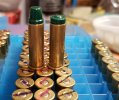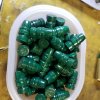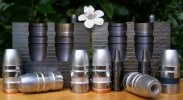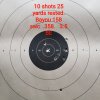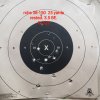Well, I'm still playing with my thoughts on proper size for a revolver. Originally, of course, all my cast bullets have been commercial cast and rather hard, and I just automatically purchased them in .358. And those fit good in my Blackhawk cylinders. On this revolver (1965 S&W model 14-2, which I'd rather not unnecessarily abuse), I cannot push those hard cast bullets through the cylinder without a lot of hard tapping with a mallet. The .357 I can gently tap through. My thoughts (and I may be way off) is that the hard cast at .358 will simply become a .357 after passing through the cylinder anyway, and is just unnecessary abuse when firing. But now that I can make my own, and can control the alloy, I think the abusive sizing through the cylinder will be gentler with a softer bullet. I see no real benefit to a bullet more than .001 larger than the cylinder throats. What I really need to do is have the cylinder throats opened up so I can shoot a bullet that is .001/ .002 over the bore. I think a softer alloy sized at .358 with the .357 cylinder throats should be a good combo until I can do that. We will find out.

